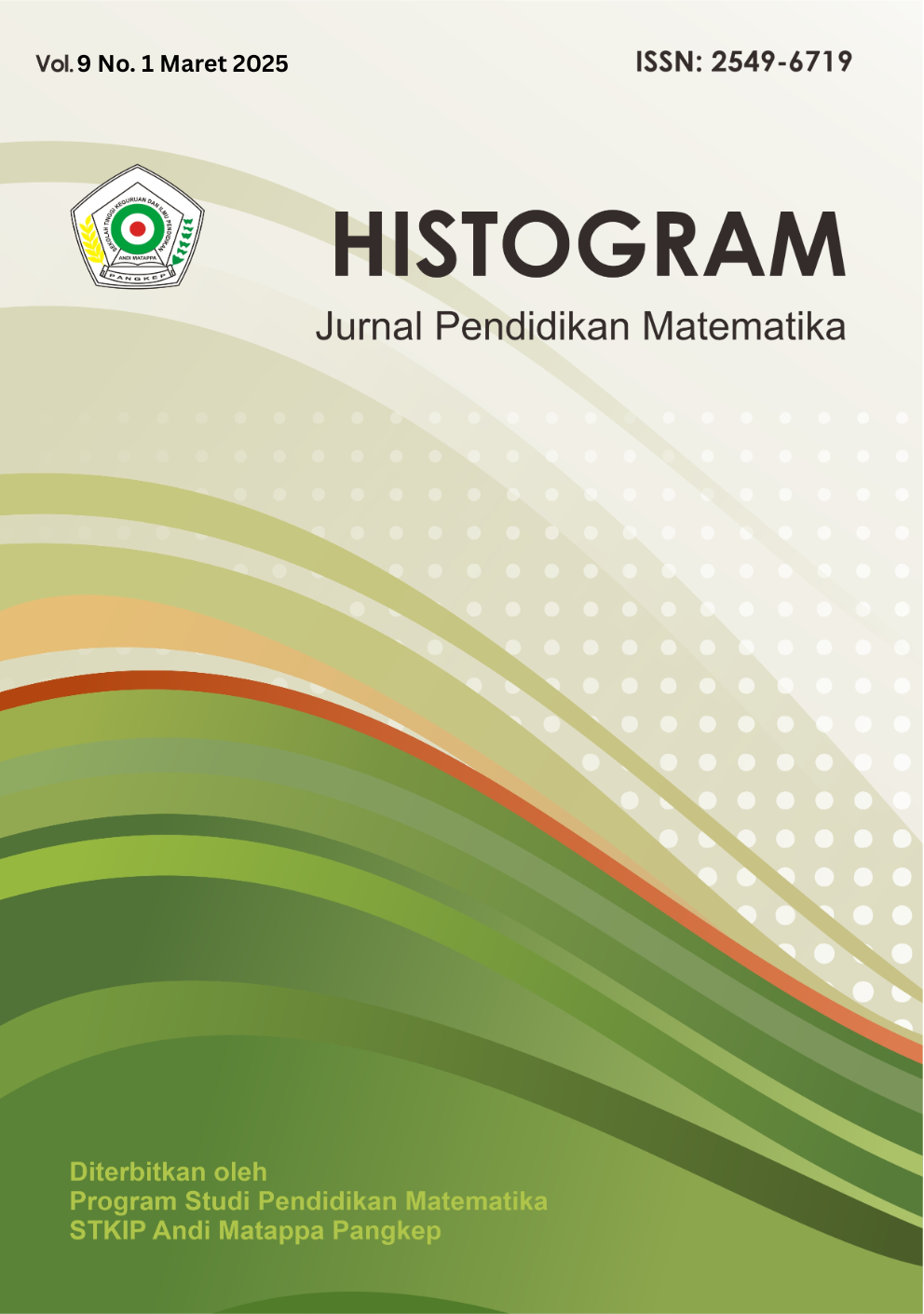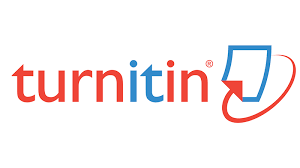PENGEMBANGAN MEDIA INTERAKTIF PHYTALEARN BERBASIS ANDROID DALAM PEMBELAJARAN TEOREMA PHYTAGORAS
DOI:
https://doi.org/10.31100/histogram.v9i1.4199Keywords:
Media Interaktif, PhytaLearn, Pembelajaran Matematika, Teorema PythagorasAbstract
ABSTRAK
Artikel ini membahas pengembangan media interaktif PhytaLearn berbasis Android dalam pembelajaran matematika untuk siswa SMP, dengan fokus pada materi Teorema Pythagoras. Penelitian ini bertujuan untuk menciptakan media pembelajaran yang dapat meningkatkan pemahaman konsep siswa dan motivasi belajar. Metode yang digunakan adalah Research and Development (R&D) dengan model pengembangan 4D, yang meliputi tahap Define, Design, Develop, dan Disseminate. Hasil validasi dari ahli menunjukkan bahwa aspek kompetensi dan materi mendapatkan skor yang sangat layak, dengan rata-rata penilaian mencapai 93%. Uji coba lapangan dilakukan dengan purposive sampling terhadap 6 siswa (2 siswa berkemampuan tinggi, 2 berkemampuan sedang, dan 2 berkemampuan rendah), serta uji kelompok besar terhadap 25 siswa kelas VIII yang menunjukkan efektivitas media dalam meningkatkan hasil belajar. Evaluasi dan revisi akhir dilakukan berdasarkan analisis data hasil implementasi. Produk final kemudian siap disebarluaskan ke sekolah-sekolah lain. Diharapkan, media interaktif ini dapat memberikan pengalaman belajar yang menyenangkan dan efektif bagi siswa dalam memahami konsep matematika, khususnya Teorema Pythagoras.
ABSTRACT
This article discusses the development of Android-based interactive media called PhytaLearn for junior high school mathematics learning, focusing on the Pythagorean Theorem. This study aims to develop learning media to enhance students’ conceptual understanding and learning motivation. The method used is Research and Development (R&D), employing the 4D development model comprising the Define, Design, Develop, and Disseminate stages. Validation results from experts indicate that the competency and content aspects received excellent scores, with an average rating of 93%. Field testing was conducted through purposive sampling involving six students (two high-ability, two moderate, and two low-ability), followed by a large-group trial involving 25 eighth-grade students, demonstrating the media’s effectiveness in improving learning outcomes. A final evaluation and subsequent revisions were conducted based on implementation data analysis. The final product is now ready to be disseminated to other schools. This interactive media is expected to provide students with an engaging and practical learning experience in understanding mathematical concepts, particularly the Pythagorean Theorem.
References
Artanti, Y., Nuryadi, N., & Marhaeni, N. H. (2021). Design of TePytha-App to Improve Mathematics Learning Achievement in Pythagorean Theorem Material. Multidiscipline International Conference, 470–477. https://ejournal.unwaha.ac.id/index.php/ICMT/article/view/2353
Artanti, Y., Nuryadi, N., & Marhaeni, N. H. (2022). Peningkatan Prestasi Belajar Matematika pada Materi Teorema Pythagoras Menggunakan Aplikasi Tepytha. Transformasi: Jurnal Pendidikan Matematika dan Matematika, 6(1), 25–38. https://doi.org/10.36526/tr.v6i1.1935
Cahyani, Y., & Patrikha, F. D. (2019). Pengembangan Media Pembelajaran Berbasis Android dengan Software Construct 2 pada Kompetensi Dasar Modal Usaha Kelas X Bisnis Daring dan Pemasaran SMK Negeri 2 Blitar. Jurnal Pendidikan Tata Niaga, 7(3). https://doi.org/10.26740/jptn.v7n3.p%25p
Cipta, G. T., Runtu, P. V. J., & Sumarauw, S. J. A. (2024). Pengembangan Media Pembelajaran Interaktif Materi Teorema Pythagoras Berbasis Adobe Animate CC. Jurnal Cendekia : Jurnal Pendidikan Matematika, 8(3), 2003–2014. https://doi.org/10.31004/cendekia.v8i3. 3288
Ekayani, P. (2017). Pentingnya Penggunaan Media Pembelajaran untuk Meningkatkan Prestasi Belajar Siswa. Jurnal Fakultas Ilmu Pendidikan Universitas Pendidikan Ganesha Singaraja, 2(1), 1–11. https://www.researchgate.net/publication/315105651_PENTINGNYA_ PENGGUNAAN_MEDIA_PEMBELAJARAN_UNTUK_MENINGKATKAN_PRESTASI_BELAJAR_SISWA
Ismanto, E., Novalia, M., & Herlandy, P. B. (2017). Pemanfaatan Smartphone Android sebagai Media Pembelajaran bagi Guru SMA Negeri 2 Kota Pekanbaru. Jurnal Pengabdian untukMu NegeRI, 1(1), 42–47. https://doi.org/10.37859/jpumri.v1i1.33
Istiqlal, M. (2017). Pengembangan Multimedia Interaktif dalam Pembelajaran Matematika. JIPMat, 2(1), 43–54. https://doi.org/10.26877/jipmat.v2i1.1480
Jannah, M., Husna, A., & Nurhalimah, S. (2020). Pembuatan Aplikasi Android dengan Cepat Menggunakan Ispring untuk Menunjang Pembelajaran secara Daring. Vektor: Jurnal Pendidikan IPA, 1(2), 66-72. https://vektor.uinkhas.ac.id/index.php/vtr/article/download/ 8/20/118
Julita, & Purnasari, P. D. (2022). Pemanfataan Teknologi sebagai Media Pembelajaran dalam Pendidikan Era Digital. Journal of Educational Learning and Innovation (ELIa), 2(2), 227–239. https://doi.org/10.46229/elia.v2i2.460
Mashuri, D. K., & Budiyono. (2020). Pengembangan Media Pembelajaran Video Animasi Materi Volume Bangun Ruang untuk SD Kelas V. JPGSD: Jurnal Pendidikan Guru Sekolah Dasar, 8(5), 893–903. https://ejournal.unesa.ac.id/index.php/jurnal-penelitian-pgsd/article/view/35876
Oktavia, R. (2022). Kebutuhan Pengembangan Media Pembelajaran Berbasis Augmented Reality (AR) pada Pembelajaran Biologi di SMA 1 Pante Ceureumen Aceh Barat. Jurnal Bionatural, 9(2), 26–32. https://doi.org/10.61290/bio.v9i2.135
Oktaviana. N, S., & Saputra, M. I. (2024). Implementasi Model Pembelajaran Berbasis Proyek dalam Meningkatkan Kemandirian Belajar Siswa. At-Ta’dib: Jurnal Ilmiah Prodi Pendidikan Agama Islam, 16(1), 118–130. https://doi.org/10.47498/tadib.v16i1.2941
Pangestu, Y. S., & Setyadi, D. (2020). Pengembangan Media Pembelajaran Aplikasi Android Pytha Fun untuk Teorema Pythagoras SMP. Jurnal Cendekia : Jurnal Pendidikan Matematika, 4(1), 113–125. https://doi.org/10.31004/cendekia.v4i1.177
Pratidiana, D. (2021). Optimalisasi Penggunaan Teknologi Pembelajaran Mahasiswa Pendidikan Matematika UNMA Banten. GAUSS: Jurnal Pendidikan Matematika, 4(2), 11–20. https://doi.org/10.30656/gauss.v4i2.3554
Pratiwi, R., & Musdi, E. (2021). Meningkatkan Kemampuan Pemecahan Masalah Matematis Peserta Didik melalui Model Pembelajaran Problem Based Learning. Jurnal Edukasi dan Penelitian Matematika, 10(1), 85–91. https://ejournal.unp.ac.id/students/index.php/pmat/article/down load/11481/4569
Riduwan. (2019). Belajar Mudah Penelitian: Untuk Guru-Karyawan dan Peneliti Pemula. Alfabeta CV.
Roisiyah, F. (2024). Problematika Pembelajaran Matematika pada Materi Fungsi dan Pemodelannya. Maliki Interdisciplinary Journal, 2(11), 49–53. https://urj.uin-malang.ac.id/index.php/mij/article/view/9828
Suparyati, A. (2018). Peningkatan Minat Belajar Siswa terhadap Pembelajaran Animasi 2D melalui Media Berbasis Android Appy Pie di Sekolah Menengah Kejuruan. Edudikara: Jurnal Pendidikan dan Pembelajaran, 3(2), 180–189. https://doi.org/10.32585/edudikara.v3i2.98
Susanti, V. D., Suprapto, E., & Wardani, Y. A. (2022a). Development of Android-Based Edutainment Game Learning Media on Pythagoras Theorem for Junior High School Students. AL-ISHLAH: Jurnal Pendidikan, 14(3), 3931–3942. https://doi.org/10.35445/alishlah.v14i3.1978
Utari, A. F., & Setyadi, D. (2023). Pengembangan Media Pembelajaran Berbasis Pop-Up Book Materi Teorema Pythagoras pada Kelas VIII SMP. Math Didactic: Jurnal Pendidikan Matematika, 9(3), 497–507. https://doi.org/10.33654/math.v9i3.2158
Wahusna, Z., Sripatmi, Junaidi, & Kurniati, N. (2022). Kemampuan Berpikir Kreatif dalam Memecahkan Masalah Teorema Pythagoras Ditinjau dari Gaya Belajar Siswa Kelas VIII SMPN 1 Taliwang Tahun Pelajaran 2021/2022. Griya Journal of Mathematics Education and Application, 2(4), 1002–1021. https://doi.org/10.29303/griya.v2i4.247
Widiastari, N. G. A. P., & Puspita, R. D. (2024). Penggunaan Media Pembelajaran Digital dalam Mengembangkan Motivasi Belajar Siswa Kelas IV SD Inpres 2 Nambaru. ELEMENTARY: Jurnal Inovasi Pendidikan Dasar, 4(4), 215–222. https://doi.org/10.51878/elementary.v4i4. 3519
Widyaningsih, N., Komalasari, M. D., & Purmomo, H. (2021). Pelatihan Pembuatan Media Pembelajaran Interaktif Berbasis Online pada Guru Sekolah Dasar. Indonesian Journal of Community Service, 1(2), 347–361. http://ijocs.rcipublisher.org/index.php/ijocs/article/view/70
Downloads
Published
Issue
Section
Citation Check
License
Copyright (c) 2025 Surya Sari Faradiba, Ahmad Sufyan Zauri, Yuli Ismi Nahdiyati Ilmi, Gusti Firda Khairunnisa, Fadhila Kartika Sari, Muhamad Isroful Fahmi

This work is licensed under a Creative Commons Attribution-NonCommercial-NoDerivatives 4.0 International License.
Please find the rights and licenses in Histogram: Jurnal Pendidikan Matematika. By submitting the article/manuscript, the author(s) accept this policy.
1. License
The non-commercial use of the article will be governed by the Creative Commons Attribution license as currently displayed on Creative Commons Attribution-ShareAlike 4.0 International.
2. Author's Warranties
The author warrants that the article is original, written by a stated author(s), has not been published before, contains no unlawful statements, does not infringe the rights of others, is subject to copyright that is vested exclusively in the author and free of any third party rights, and that any necessary written permissions to quote from other sources have been obtained by the author(s).
3. User Rights
Histogram: Jurnal Pendidikan Matematika's spirit is to disseminate articles published for free. Under the Creative Commons license, Histogram: Jurnal Pendidikan Matematika permits users to copy, distribute, display, and perform the work for non-commercial purposes only. Users will also need to attribute authors and Histogram: Jurnal Pendidikan Matematika when distributing works in the journal.
4. Rights of Authors
Authors retain all their rights to the published works, such as (but not limited to) the following rights;
- Copyright and other proprietary rights relating to the article, such as patent rights,
- The right to use the substance of the article in one's future works, including lectures and books,
- The right to reproduce the article for one's purposes,
- The right to self-archive the article,
- The right to enter into separate, additional contractual arrangements for the non-exclusive distribution of the article's published version (e.g., post it to an institutional repository or publish it in a book), with an acknowledgment of its initial publication in this journal (Histogram: Jurnal Pendidikan Matematika).
5. Co-Authorship
If other authors jointly prepared the article, any author submitting the manuscript warrants that all co-authors have authorized them to agree on this copyright and license notice (agreement) on their behalf and agree to inform their co-authors of the terms of this policy. Histogram: Jurnal Pendidikan Matematika will not be held liable for anything arising from the author(s) internal dispute. Histogram: Jurnal Pendidikan Matematika will only communicate with the corresponding author.
6. Royalties
This agreement entitles the author to no royalties or other fees. To such an extent that it is legally permissible, the author waives their right to collect royalties relative to the article regarding any use by Histogram: Jurnal Pendidikan Matematika.
7. Miscellaneous
Histogram: Jurnal Pendidikan Matematika will publish the article (or have it published) in the journal if the editorial process is completed. Histogram: Jurnal Pendidikan Matematika h editors may modify the article to a style of punctuation, spelling, capitalization, referencing, and usage that deems appropriate. The author acknowledges that the article may be published to be publicly accessible, and such access will be free of charge for the readers, as mentioned in point 3.





